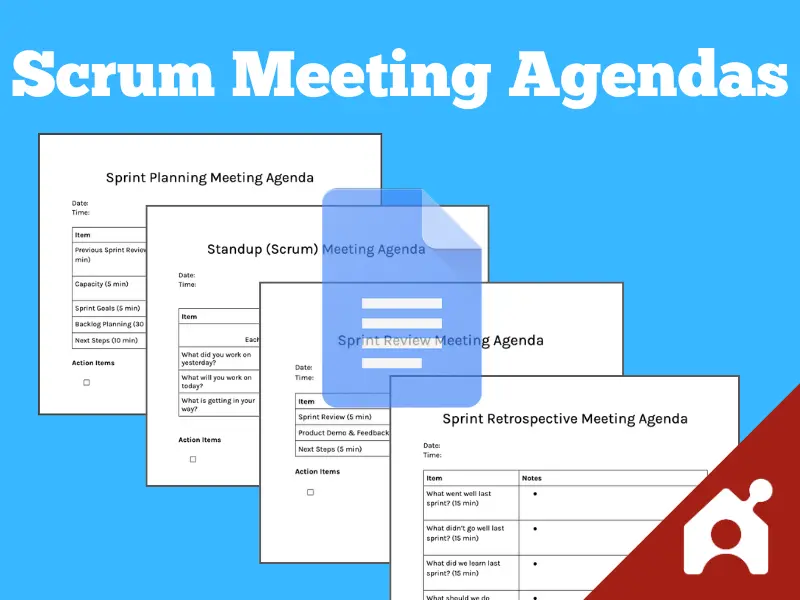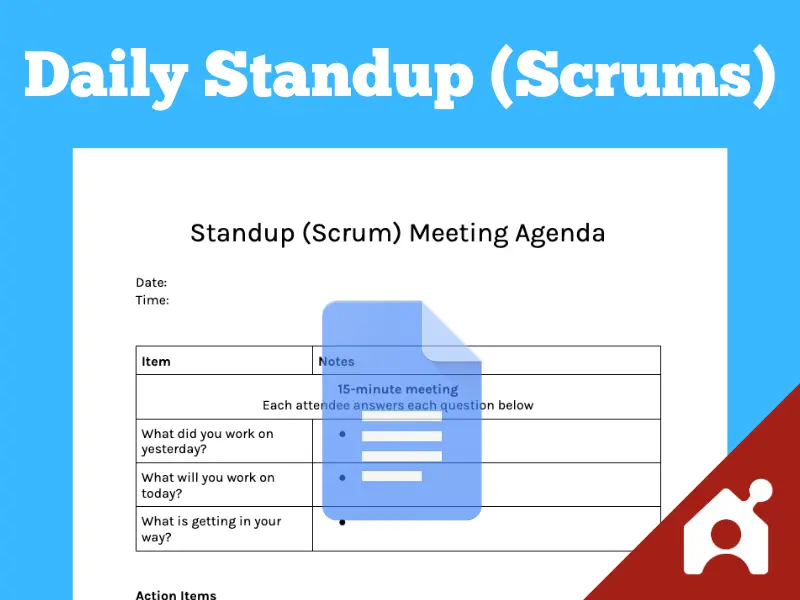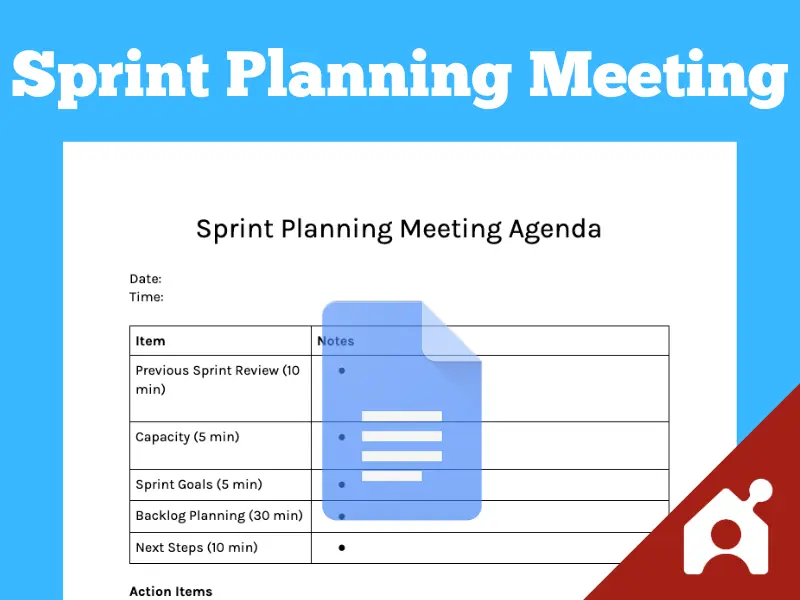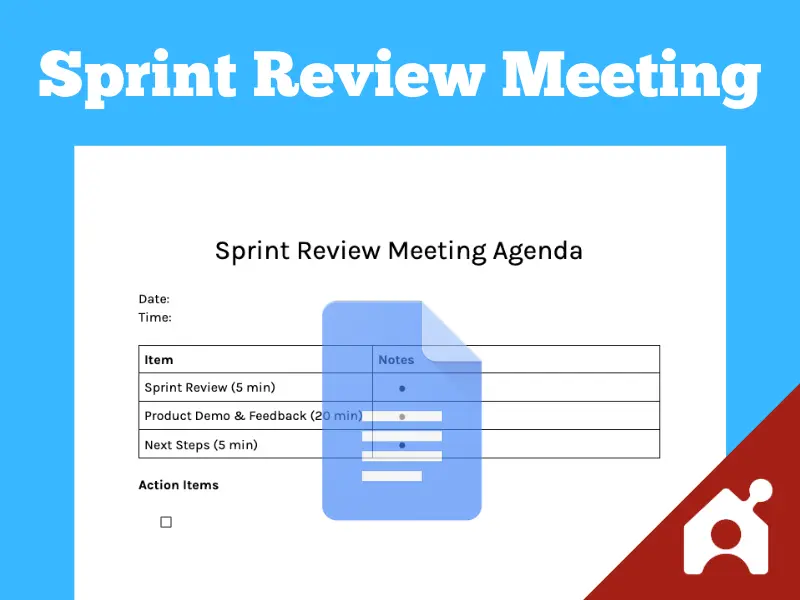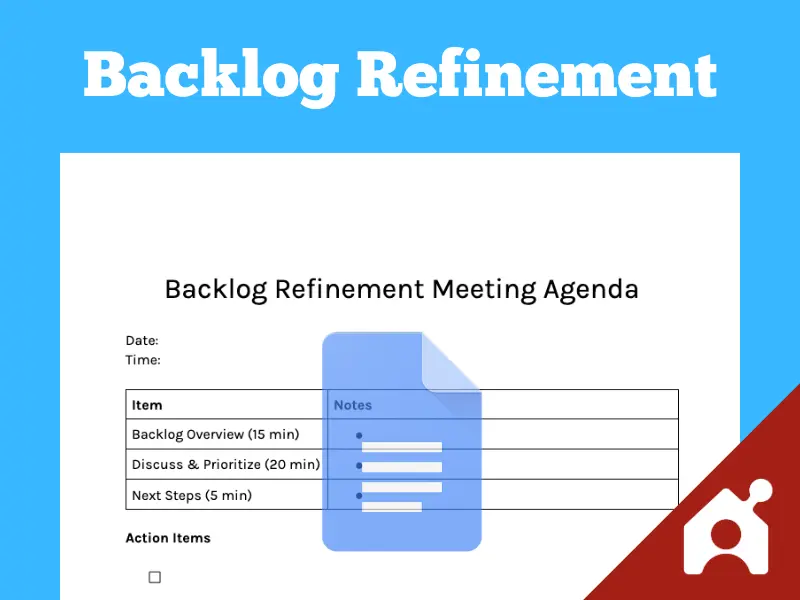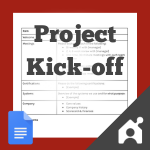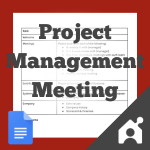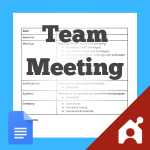The Only 5 Scrum Meeting Agenda Templates You Need
This is part of our series on meeting agenda templates. You can edit these Agile/Scrum meeting agendas in Google Docs or Word or print them out.
Meeting Agenda Templates > Project Management Agendas > Scrum Meeting Agendas
At the marketing agency I ran for six years, our project management mindset and system got too heavy and slow. We were organized but we had sets of dependent tasks and the management of the work took almost as long as the work itself. It bogged us down.
After some research, we switched over to the “Agile” project management methodology and implemented it through “Scrum.” We made that move in 2017 and the company continues to operate that way until today.
| Quick Note on Agile vs. Scrum |
|---|
“Agile” and “Scrum” are often used interchangeably. I don’t think it matters much, but those are technically different ideas within project management and product development:
|
In the article below, you’ll see the only five scrum meeting agendas used to implement an agile approach to project management. I have personally run all five of these scrum meetings but ended up running just three by the end (you need to protect your team from ‘death by meeting‘) and stopping daily standups.
Table of Contents
- Who attends scrum meetings?
- Tips for running scrum meetings
- Agenda templates
- Download these agendas (and many more) in the meeting agenda library
Who attends scrum meetings?
This is generally who will attend all five types of scrum meetings.
- Scrum Master
- Facilitator: The Scrum Master ensures that the meetings run smoothly and stays within the time limit.
- Scrum Coach: Acts as a coach to the team, helping members use the Scrum methodology correctly and efficiently.
- Roadblock Remover: Identifies obstacles that team members raise during the meeting and helps to turn them into tasks to fix said obstacles.
- Product Owner
- Visionary: Represents the stakeholders (clients, management team, etc.) and the voice of the customer.
- Decision Maker: Makes strategic product decisions and prioritizes the backlog items, helping the team understand which tasks are most critical and why.
- Project Team Members
- All software developers or people who participate on the priorities of the sprint
- Stakeholders (optional)
- Clients (if this is an external project)
- Management team (as silent observers)
How To Run Scrum (& Scrum Meetings) Effectively
After five years of running a marketing agency team with Scrum, here are some unique things I learned (and wanted to pass on to you):
- The point of agile is to do more and plan less. Therefore, you should not bog your team down with meetings. Find ways to cut down on meetings wherever possible.
- If you run all five of these meetings as recommended, you’ll have far too many meetings. Run them all to start, but find ways to cut down (like daily standups to twice weekly, or combining sprint planning and sprint review).
- Daily standups can be dangerous. By meeting daily, you may incentivize people to work on things that can be done in one day (urgent but not important things). We moved to twice-weekly standups to avoid this.
- Standups can be asynchronous. If you want to really remove some overhead, switch your standups to written updates. This accomplishes the same goal without taking everyone’s time at a certain point of every day.
- Consider time zone differences. If your team is all over the world, asynchronous standups will work better. If you are all if the US, try to find a morning time for all.
- Retrospectives tend to be very negative. In a retrospective, you are looking for ways to improve so you look for the bad things. That’s a good process, but it turns into a negative. Consider moving the “What went well?” section to the end so you end on a high note.
- As Scrum Master, it is your job to keep people out of the minutia. Pull people out of their detailed tasks and up a level.
- Stay on time. If you can’t get a standup done in 15 minutes, something is wrong.
- Screenshare or visually share the backlog board as you talk.
👉 Scrum Meeting Agenda Templates 👈
Here are the five scrum meeting agendas you’ll need. Keep an eye on the notes so you can find ways to cut down on meeting time without compromising your results.
1. Standup (Daily Scrum) Meeting Agenda
Access the free agenda in Docs | Download all 50 for $47
Purpose: To synchronize activities and create a plan for the next 24 hours in a development team or a team working on a project together.
Template:
- Attendees: All team members working on the project, Scrum Master
- Frequency: Daily
- Duration: 15 minutes
Process:
- Start and end on time
- Set a consistent time for the meeting to occur each day
- Screenshare your project management board
- Go around one-by-one to share updates
Agenda:
- What did you work on yesterday?
- What will you work on today?
- What is getting in your way?
2. Sprint Planning Meeting Agenda
Access the free agenda in Docs | Download all 50 for $47
Purpose: To outline the work to be performed during the sprint (a set period of time like one, two, or four weeks), the goal of the sprint, and the capacity of the team during the sprint.
Template:
- Attendees: All project team members, Scrum Master, Product Owner
- Frequency: At the start of each sprint (1, 2, or 4 weeks typically)
- Duration: 1 hour
Agenda:
- Previous Sprint Review (10 minutes)
- What was completed?
- What wasn’t?
- What got in the way?
- Capacity (5 minutes)
- Do people need to make adjustments to their typical sprint workload? (ie. vacations, priorities outside of the sprint like hiring or quarter-close projects)
- Sprint Goals (5 minutes)
- Discuss: What needs to be accomplished in this sprint to consider it a success? Why is that the focus?
- Backlog Planning (30 minutes)
- Which priorities should go into the backlog to be completed during this sprint?
- Next Steps (10 minutes)
- Who is assigned which priority?
- What needs to happen next to get started well during this sprint?
3. Sprint Review Meeting Agenda
Access the free agenda in Docs | Download all 50 for $47
Important Notes:
- This can be combined with the sprint planning meeting, especially if it is all internal. See the first section of the previous agenda just above this.
- A sprint review meeting might be necessary if you are delivering externally to clients (as an agency). This could act as its own presentation/meeting.
Purpose: To inspect the outcome of the sprint (a product demo) and discuss what went well and what could’ve been done better.
Template:
- Attendees: All project team members, Scrum Master, Product Owner, Clients (if necessary)
- Frequency: At the end of each sprint (1, 2, or 4 weeks typically)
- Duration: 30 minutes
Agenda:
- Sprint Review (5 minutes)
- What was accomplished during the previous sprint?
- Product Demo & Feedback (20 minutes)
- Screenshare new features, functionality
- Collect feedback, issues, and ideas
- Next Steps (5 minutes)
- Does anything need to change in the next sprint based on what was discussed today?
- Exactly what happens next to continue the project successfully?
4. Sprint Retrospective Meeting Agenda
Access the free agenda in Docs | Download all 50 for $47
Important Notes:
- This could also be combined with the sprint review meeting (if you choose not to combine sprint review with sprint planning).
- This meeting inherently skews negative – you are collectively finding ways to improve and things that went well, you, therefore, won’t discuss much. Consider asking “What went well?” as the last question.
- Here are the main differences between these three similar-sounding meetings:
- Sprint planning: move around priority cards to set up the next sprint
- Sprint review: view the actual upgrades to the product and discuss
- Sprint retrospective: discuss how to improve your process (not priority/task-based)
Purpose: To reflect on the past sprint (people, relationships, processes, and tools) so that you can improve for the next sprint.
Template:
- Attendees: All project team members, Scrum Master, Product Owner (optional)
- Frequency: At the end of each sprint (1, 2, or 4 weeks typically)
- Duration: 1 hour
Agenda:
- What went well last sprint? (15 minutes)
- Discuss things that should be continued
- What didn’t go well last sprint? (15 minutes)
- Discuss things that got in the way of success and why
- What did we learn last sprint? (15 minutes)
- Discuss ideas or process improvements that were discovered last sprint and should be maintained
- What should we do differently next sprint? (15 minutes)
- Discuss specific ways to change to clear roadblocks
- Record the exact tasks that need to be completed (and by whom)
5. Backlog Refinement Meeting Agenda
Access the free agenda in Docs | Download all 50 for $47
Important Notes:
- Backlock refinement is a higher-level discussion than sprint planning – they should take place less frequently a they should aim to tie sprints to the overall project goal.
- Backlog refinement is more of a nice-to-have whereas sprint planning is a must-have (if you’re looking to cut down on meetings)
Purpose: To review items in the backlog to make sure the team is working on the right items toward the larger goal.
Template:
- Attendees: All team members (or just a few like the Scrum Master and Product Owner)
- Frequency: Every other sprint (2, 4, or 6 weeks typically), or Adhoc
- Duration: 45 minutes
Agenda:
- Backlog Overview (15 minutes)
- Review of the backlog for the next sprint few sprints
- Discuss & Prioritize (20 minutes)
- Which priorities could be removed?
- Which user stories should be prioritized?
- Are any important ones missing?
- Put an estimation of effort on each backlog item
- Next Steps (5 minutes)
- What needs to be communicated to the team?
Similar Meeting Agendas
Click the links below to access another meeting agenda template.
View the complete meeting agenda template library
Download This (& More) Meeting Agendas
Want to download this meeting agenda in Google Docs or Word?
It’s part of our meeting agenda library that you can download here.

